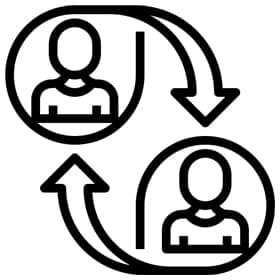The CBT Working Alliance
The therapeutic relationship in CBT is often referred to as the ‘CBT working alliance’; this term in itself reflects the fact that it is different in this modality from others.
The word ‘working’ shows the action-oriented nature of CBT work, with the client as well as the therapist having to put in active work.
The word ‘alliance’ recognises that this is a collaborative effort between client and therapist, in which they are working together – as allies – to help the client affect the changes they wish to make.

Three Key Strands
In a 1979 paper published in Psychotherapy: Theory, Research & Practice (252–260), Edward Bordin asserted that the working alliance has three key strands:
- agreement on goals
- assignment of tasks
- development of bonds
This reflects the fact that as well as the quality of the relationship (i.e. development of bonds), both goal-setting (often using SMART methodology) and assigning tasks (in the form of exercises during the session and also as homework) are similarly important.
Implicit versus Explicit Strands
In the therapeutic relationship, some aspects may be implicit, while others are explicit.
Explicit aspects are those that are clearly out in the open through being expressed; they may even be directly discussed in contracting.
For example, explicit aspects may include specific statements by the therapist during the initial session that clients cannot receive therapy if under the influence of drugs or alcohol (e.g. in an addiction charity, in order to ensure psychological contact) – and that the client will be expected to be actively involved in the therapy, to undertake homework and to accept personality responsibility for change.
In order to detect implicit aspects of the therapeutic relationship, the therapist must be sensitive to how the client relates to them and the joint work, for example picking up on subtle signs of unduly positive or negative reactions.
These warning signs could indicate the presence of transference/countertransference and/or parallel process.
Transference involves the client unconsciously transferring feelings and attitudes relating to a person from their past onto the therapist in the present, e.g. if the therapist reminds them of, say, a teacher or parent.
Countertransference describes the response to this in the therapist, or when the therapist unconsciously sees a figure from their own past in the client.
Parallel process, meanwhile, occurs when the therapist sees themselves and their own experiences mirrored in the client’s process.
Transference and Countertransference
Transference/countertransference and parallel process should ideally be quickly picked up on by the therapist, helped by their self-awareness and personal-development work during counselling training.
However, these are not always immediately obvious to the therapist (though they may be aware of some emotions and/or thoughts that feel somehow out of place in the counselling room).
This is a key purpose of clinical supervision, where a specially trained and experienced third-party practitioner can help the therapist explore what is going on and identify any such problems.

These can then be addressed ether by undertaking personal-development work (e.g. through journaling or other reflection) or (if appropriate – i.e. of likely value to the client) bringing this into the counselling room using immediacy and congruence, in order to deepen the therapeutic relationship and help the client’s process.
As Simmons & Griffiths (2014: 46) note, ‘the relationship history of both therapist and client also has an effect on the therapeutic relationship’.
Relational Factors
In modern times, Mick Cooper has investigated the extent to which four categories of factors – client factors, therapist factors, relational factors, and technique and practice factors – relate to the effectiveness of therapy outcomes.
In his book Essential Research Findings in Counselling and Psychotherapy: The Facts Are Friendly (Sage, 2008), Cooper describes the relational factors that have been demonstrated in research, drawing on the work of several key researchers including Ahn & Wampold (whose meta-analysis ‘Where oh where are the specific ingredients?’ was published in 2001), and Asay & Lambert (authors of ‘The empirical case for the common factors in therapy: quantitative findings’ in 1999).
Cooper concludes that ‘demonstrably effective’ elements of the relationship are goal consensus and collaboration (in line with Bordin’s elements of goals and tasks), therapeutic alliance and empathy (the last two relating to Bordin’s bonds).
He adds that ‘promising and probably effective’ elements are the management of countertransference, feedback, positive regard, congruence, appropriate self-disclosure, relational interpretations, and repair of alliance ruptures.
Ruptures
Because of the complexities of human-to-human relationships and the diversity among people, ruptures can occur in the working alliance. These inevitably have an adverse effect on the therapy itself.
Ruptures may be triggered by therapist factors – e.g. if they are intrusive, defensive or negative, self-disclose inappropriately (i.e. in a way that is not purely in the client’s service) or challenge/push the client too much before relational depth has been established.
Ruptures may also be due to client factors, such as resistance, hostility, challenge, withdrawal and misunderstanding of in relation to certain topics.
Cultural differences can also make it more difficult to build a good working alliance between the two parties. With the right skills, the therapist can address these issues, allowing therapy to progress effectively.
Measuring the Working Alliance
In CBT, there are two important questionnaires that measure the integrity of the working alliance.
First, certain questions in Safran and Segal’s Suitability for Short-Term Cognitive Therapy Rating Scale relate directly to the therapeutic alliance (e.g. questions 5 and 6, on the client’s alliance potential – i.e. ability to form effective relationships – within and outside sessions).
Some of the other questions are indirectly related to – and can be influenced by – the working alliance too, since a strong alliance (and thus client–counsellor communication) will, for example, improve the chance of good motivation and of effective socialisation to the CBT model.
This questionnaire can be used by the therapist after the initial session to rate the client’s suitability for CBT.
Second, the Working Alliance Inventory (Short Revised) was developed by Adam Horvath to measure agreement on goals, assignment of tasks, and the development of bonds, in line with Bordin’s (1979) work, with four items in the scale relating to each of these three key strands.
Applying Theory to Practice
Ways in which it is possible to practically encourage the development of a strong working alliance, promoting collaboration and acceptance of personal responsibility, include:
- during contracting, inviting clients to ask any questions
- gaining explicit agreement to the contract by asking the client to sign this
- providing clients with their own copies of all paperwork
- setting homework tasks for the client from the first session together (e.g. an initial task of spotting and correcting irrational thinking in fictional scenarios, as practice in applying the CBT model)
- encouraging clients to take their own notes during sessions (so long as they are comfortable with writing)
- asking clients to complete the Working Alliance Inventory (perhaps as homework) after a few sessions
- eliciting feedback from clients at the end of each session.
Free Handout Download
The CBT Working Alliance
References
Ahn H & Wampold B (2001) ‘Where oh where are the specific ingredients? A meta-analysis of component studies in counseling and psychotherapy’, Journal of Counseling Psychology, 48(3), 251–257
Asay T & Lambert M (1999) ‘The empirical case for the common factors in therapy: Quantitative findings’, In Hubble M, Duncan B & Miller S (Eds.) The heart and soul of change: What works in therapy, 23–55), American Psychological Associatio
Bordin E (1979) ‘The generalizability of the psychoanalytic concept of the working alliance’, Psychotherapy: Theory, Research and Practice, 16, 252–260.
Cooper M (2008) Essential Research Findings in Counselling & Psychotherapy: The Facts Are Friendly, Sage
Simmons J and Griffiths R (2014) CBT for Beginners, Sage